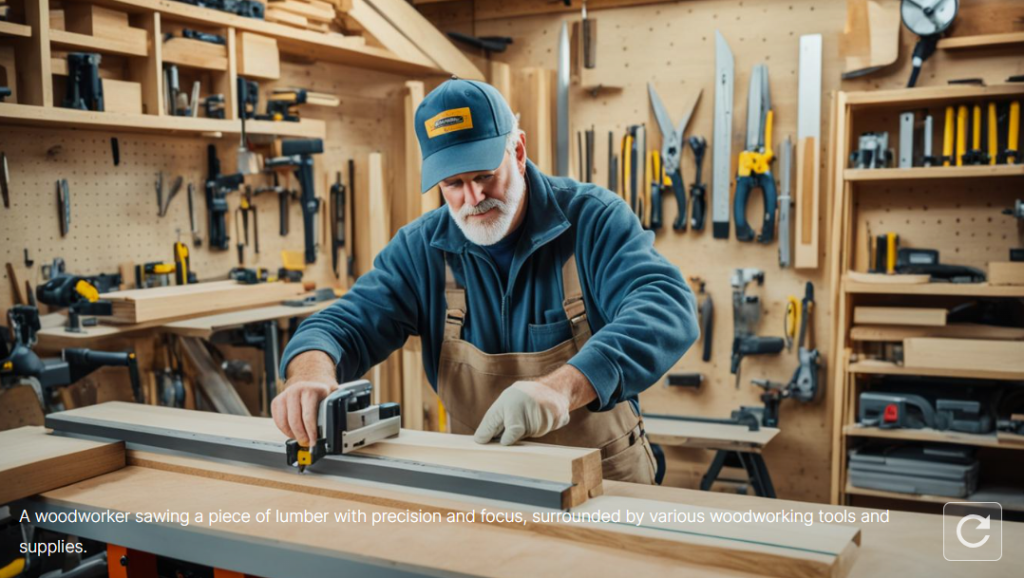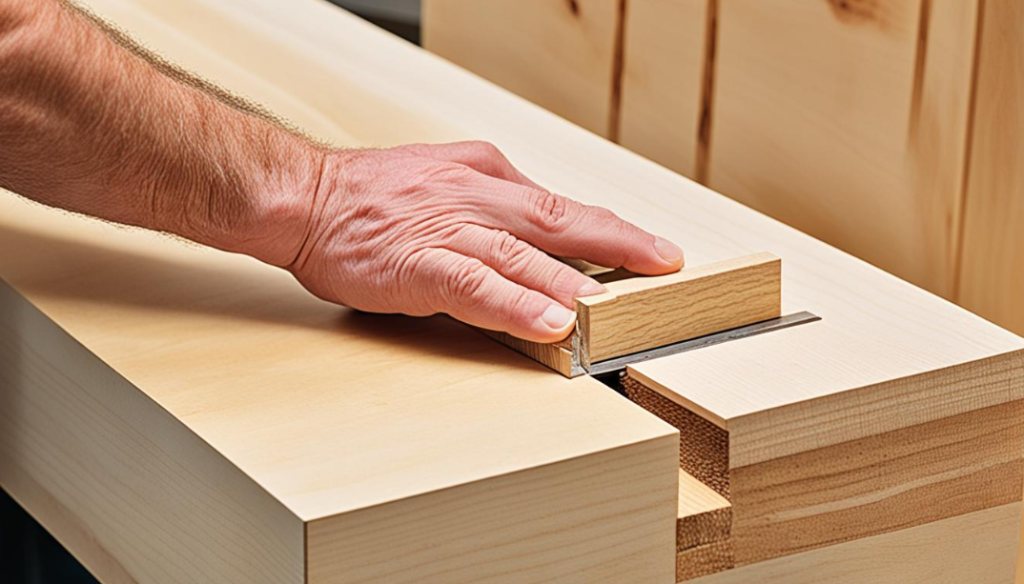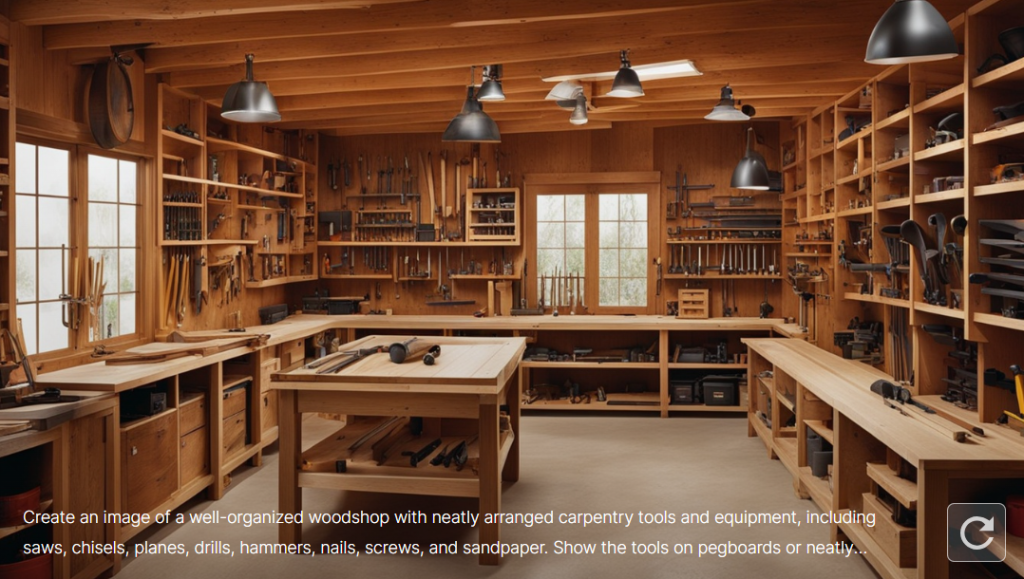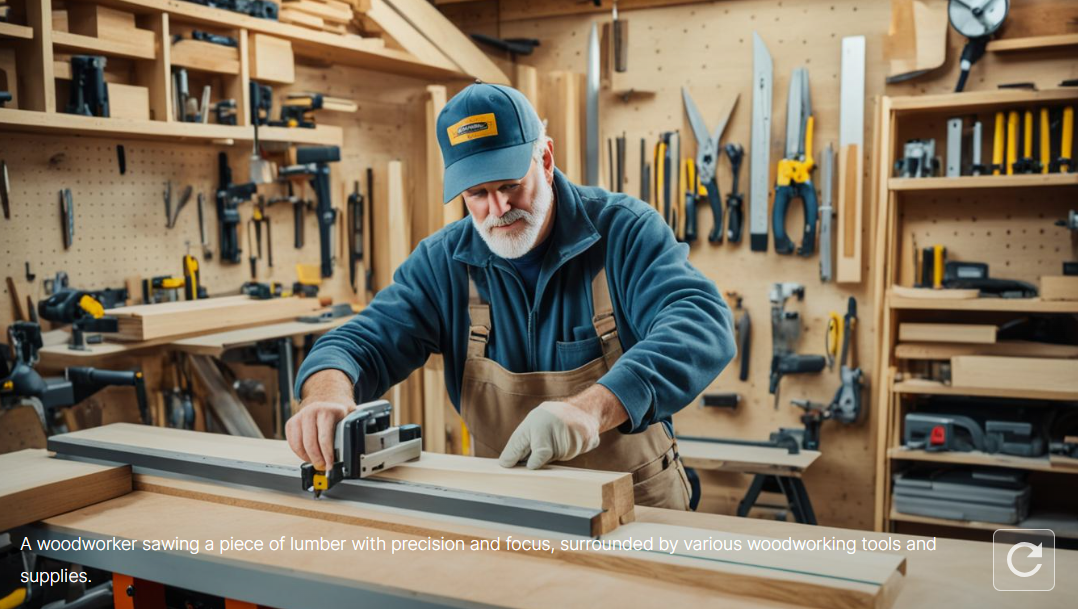Start your woodworking journey and dive into the world of timber craftsmanship. This guide is perfect for beginners or those dreaming of becoming carpenters. It covers everything from wood types to basic techniques. Let this article be your guide as you explore woodworking.

A woodworker sawing a piece of lumber with precision and focus, surrounded by various woodworking tools and supplies.
Key Takeaways
- Discover the fundamentals of woodworking and its benefits as a hobby.
- Familiarize yourself with essential woodworking tools and equipment.
- Understand the differences between softwoods and hardwoods, and explore common wood species.
- Learn about essential safety practices to ensure a safe and enjoyable woodworking experience.
- Explore the basic techniques of measuring, marking, cutting, and sawing wood.
Introduction to Woodworking
Woodworking is the art of shaping wood to make things that are both useful and pretty. It’s a hobby that lets you be creative and learn new skills. You can make furniture, wood carvings, or just enjoy working with wood.
What is Woodworking?
Woodworking means cutting, shaping, and joining wood to make items. It includes simple carpentry and complex joinery and woodcraft. Woodworkers use tools like hand tools, power tools, and machines to turn wood into beautiful things.
Benefits of Woodworking as a Hobby
Woodworking has many benefits, like:
- Developing practical skills – It teaches you how to measure, cut, and put things together. These skills are useful in many areas of life.
- Enhancing creativity – Making wood crafts lets you show off your creative side and bring your ideas to life.
- Promoting personal fulfillment – Finishing a woodworking project feels great and can make you feel happy and fulfilled.
- Fostering patience and focus – Woodworking needs careful attention and a step-by-step approach. This helps you be patient and focused.
- Reducing stress – Working with wood can be calming. It’s a way to relax and take your mind off daily worries.
Woodworking is great for beginners or those with some experience. It’s a rewarding hobby that lets you appreciate the beauty of working with wood. As you learn more about woodcraft and woodshop, you’ll grow to love it even more.
“Woodworking is not just a hobby, it’s a way of life. It’s a chance to create something beautiful and functional with your own hands.”
Essential Woodworking Tools
Starting your woodworking journey means getting the right tools. These tools are key for making beautiful projects and improve your work’s efficiency and precision. We’ll look at the must-have woodworking tools that will be your go-to in the workshop.
Saws: The Cutting Edge
Saws are at the heart of woodworking. From the classic hand saw to the powerful miter saw, they let you make precise cuts. You can shape wood just how you want it. Having a reliable saw is crucial, whether you’re doing fine joinery or cutting large pieces.
Chisels: Sculpting with Precision
Chisels help you refine and shape your woodworking projects. These sharp tools let you remove material with great control. They’re vital for tasks like mortise-and-tenon joinery, dovetailing, and detailed carving.
Planes: Smoothing the Surface
Planes make rough lumber smooth. From the simple hand plane to the advanced electric planer, they’re key for a perfect finish. With a plane, you can easily remove unwanted material and get a professional look.
Power Tools: Amplifying Your Efficiency
Hand tools are the base of traditional woodworking, but modern power tools have changed the game. Tools like power saws, routers, drills, and sanders speed up complex tasks. Adding these tools to your collection boosts your productivity and project quality.
| Woodworking Tool | Purpose | Key Features |
|---|---|---|
| Hand Saw | Cutting wood by hand | Variety of blade sizes and tooth patterns for different tasks |
| Miter Saw | Making precise miter cuts and cross-cuts | Adjustable angle settings for angled cuts |
| Chisel | Shaping and refining wood | Various widths and shapes for specific applications |
| Hand Plane | Smoothing and leveling wood surfaces | Adjustable blades for controlling depth of cut |
| Jigsaw | Cutting intricate shapes and curves | Powerful, variable-speed motor for precision control |
Getting these essential tools for your workshop is the first step to improving your skills and making great projects. Knowing what each tool does helps you make smart choices. This way, you can build a toolset that supports you in your woodworking journey.
Understanding Wood Types
In woodworking, knowing the different types of wood is key. Wood falls into two main groups: softwoods and hardwoods. Picking the right wood for your project greatly affects the outcome. So, it’s important to know their unique traits and properties.
Softwoods vs. Hardwoods
Softwoods, like pine, cedar, and fir, are light and easy to work with. They’re also more affordable and often used in building and making cabinets. Hardwoods, however, are denser and last longer. They’re great for furniture, flooring, and detailed woodworking. Maple, oak, and walnut are well-known hardwoods.
| Characteristics | Softwoods | Hardwoods |
|---|---|---|
| Density | Lighter and less dense | Heavier and more dense |
| Grain | Straight, uniform grain | Varied, intricate grain patterns |
| Durability | Less durable | More durable and resistant to wear |
| Typical Uses | Construction, framing, cabinetry | Furniture, flooring, fine woodworking |
Common Wood Species for Woodworking
Some wood species are more popular for woodworking. Here are a few:
- Oak – A hardwood known for its strength, durability, and distinctive grain patterns.
- Maple – A hardwood that is prized for its light color, smooth texture, and exceptional hardness.
- Pine – A softwood that is affordable, easy to work with, and often used in construction and basic woodworking projects.
- Cherry – A hardwood with a rich, reddish-brown color and fine grain that is popular for furniture and cabinetry.
- Walnut – A hardwood with a deep, dark color and a distinctive grain that is highly sought after for high-end woodworking projects.
Knowing the differences between softwoods and hardwoods, and the traits of common woods, helps you choose the right materials for your projects.https://www.youtube.com/embed/345OoSCJp_8
Woodworking Safety Practices
Woodworking can be a fun hobby, but it has risks. Keeping your workshop safe and following safety rules is key. This section will cover important safety tips for woodworkers.
Prioritizing Personal Protective Equipment (PPE)
Using personal protective equipment (PPE) is very important in woodworking. Good PPE can prevent serious injuries. Always wear safety glasses, hearing protection, and strong work gloves when woodworking.
Maintaining a Clean and Organized Workspace
A messy workshop is dangerous. It’s important to keep your work area clean and clear. Clean up regularly, put tools away, and avoid tripping hazards.
Proper Use of Power Tools
Power tools are key in woodworking but can be risky if not used right. Always follow the maker’s instructions for power tools. Don’t skip safety features. Keep tools in good shape and replace worn parts to stay safe.
Hand Tool Safety
Hand tools are important too. Keep them sharp and in good condition. Use them right and be careful with your hands and body.
Putting safety first makes woodworking fun and safe. Always think safety first in your workshop. This way, your woodworking can be rewarding and safe.
| Safety Gear | Importance |
|---|---|
| Safety Glasses | Protects eyes from flying debris and dust |
| Hearing Protection | Prevents hearing damage from loud power tools |
| Work Gloves | Safeguards hands from cuts, scratches, and abrasions |
| Respirator Mask | Filters out harmful wood dust and particles |
| Sturdy Footwear | Provides stability and protects feet from falling objects |
“Safety should be the top priority in any woodworking workshop. By taking the necessary precautions, you can enjoy the craft while minimizing the risks.”
Woodworking Techniques for Beginners
Learning the basic woodworking techniques is key to making great projects. We’ll cover important skills like measuring and marking, and cutting with hand and power tools. These skills are the base for more complex woodworking projects.
Measuring and Marking
Getting your measurements right is the first step to a perfect woodworking project. Get to know tools like rulers, tape measures, and calipers. Learn to read them well and mark your work accurately.
Marking your wood is crucial for precise cuts and joins. Use sharp pencils, knives, and layout tools to mark where you’ll cut and connect pieces.
Cutting and Sawing
After measuring and marking, it’s time to cut. You can use hand saws or power tools like a circular saw or jigsaw. Learn how to saw properly for clean cuts. Keep sawing steady and safe to avoid mistakes.
| Woodworking Technique | Benefits | Key Considerations |
|---|---|---|
| Measuring and Marking | Ensures accurate dimensionsGuides cuts and joineryEnhances project precision | Use sharp, precise measuring toolsDevelop a keen eye for detailPractice marking techniques |
| Cutting and Sawing | Allows for clean, straight cutsFacilitates project assemblyBuilds essential carpentry skills | Use proper saw handling techniquesPrioritize safety when operating toolsPractice cutting on scrap wood first |
Mastering these basic woodworking techniques will help you make beautiful wood crafts. Always focus on safety and practice on scrap wood before your final project.
Joining Wood: Joinery Techniques
Woodworking is more than just shaping and sculpting wood. It’s also about joining pieces together perfectly. Joinery techniques are key to making wooden structures strong, durable, and look great. They’re used in everything from simple furniture to complex cabinetry. Let’s look at some common and effective woodworking joinery methods that every carpenter and cabinetmaker should know.
Dovetail Joints
The dovetail joint is a classic and strong joinery technique. It looks like a puzzle piece and is known for its strength. Learning to do dovetail joints is a great challenge for woodworkers. It requires precise measurements and careful work.
Mortise and Tenon Joints
The mortise and tenon joint is another basic carpentry joinery method. It involves making a hole (mortise) in one piece and a matching piece (tenon) on the other. These joints fit together well and are often used in furniture making. They add strength and stability to frames and other parts.
Lap Joints
Lap joints, also called butt joints, are a simple way to connect wood pieces. They involve cutting away a bit of each piece so they overlap and can be glued or nailed together. Lap joints are great for simple projects like boxes or frames because they’re easy to do.
Learning these joinery techniques is important for any woodworker. Knowing the best method for your project helps make sure your work is strong and looks good.

Show a close-up of two pieces of wood being joined together using a dovetail joint. The grains of the wood should be visible, and the joint should be snug and seamless. The image should convey precision and craftsmanship, with no visible gaps or imperfections in the joinery.
“The quality of a joint is the soul of a project.” – Krenov, a renowned woodworking author and teacher.
Finishing and Staining Wood
The final step in woodworking is adding a wood finishing layer. This step boosts the wood’s natural beauty and protects it. We’ll look at wood finishes and how to apply them for a great look.
Types of Wood Finishes
There are many wood finishing options, each with its own benefits:
- Varnishes give a tough, shiny finish that resists scratches and wear.
- Lacquers create a smooth, shiny look and dry fast, making them great for furniture and cabinets.
- Oils go deep into the wood, highlighting its natural color and texture, and offer some protection.
- Stains change the wood’s color, offering various shades and finishes.
- Sealants protect the wood from moisture, dirt, and other environmental factors.
Applying Finishes Correctly
Getting wood finishing right is key for a professional look. Here are some tips:
- Sand the wood well to remove dirt or debris.
- Apply the finish in thin, even layers, following the instructions for drying times and coats.
- Use the right tool, like a brush or lint-free cloth, for an even finish.
- Sand lightly between coats for a smooth surface.
- Keep the finished piece in a clean, dry place and avoid too much handling or moisture.
Knowing the different wood finishing options and how to apply them can transform your projects. With the right wood care methods, your work will last long and look great. Enjoy your creations for years to come.
“The secret to a perfect wood finish is in the preparation. Take the time to sand and clean the surface, and your finish will reward you with a beautiful, durable result.”
Woodworking Projects for Beginners
Once you’ve learned the basic woodworking techniques, it’s time to try them out. We’ll look at beginner-friendly woodworking projects like simple furniture, decorations, and useful items for the house. These projects will boost your confidence and encourage you to try harder woodworking projects later.
Simple Furniture Projects
Creating simple furniture is a great way for beginners to start. Think about making a wood craft like a DIY woodworking end table, a basic bookshelf, or a small side table. These projects help you practice important skills like measuring, cutting, and joining. Plus, you’ll end up with useful and nice-looking pieces for your home.
Decorative Wood Crafts
For a creative challenge, try woodworking projects that make decorative wood crafts. You can make wooden signs, wall hangings, boxes, or bowls. These projects let you show off your artistic side and improve skills like sanding, finishing, and precise cutting.
Functional Household Items
Beginner woodworking is also great for making everyday items for your home. Think about making a simple DIY woodworking cutting board, a birdhouse, or wooden coasters. These projects improve your skills and give you unique items for your home.
Remember, the secret to doing well in woodworking projects is to start small, focus on the basics, and enjoy the process. With time and practice, you’ll be ready for more complex wood crafts and DIY woodworking projects.
“The true joy of woodworking lies in the journey, not just the destination. Every project is an opportunity to learn, grow, and create something truly unique.”
Maintaining and Caring for Woodworking Tools
Keeping your woodworking tools in good shape is key to their longevity and performance. Clean, sharpen, and store your tools right to keep them ready for your next project. We’ll share tips to keep your tools in top shape, making them more efficient and lasting longer.
Cleaning and Storing Tools
Cleaning your tools regularly is a must. Wipe them down with a clean, dry cloth after each use to remove dust and debris. For tough buildup, use a mild solvent or degreaser, but avoid soaking the tools. Store your tools in a dry, organized spot to prevent rust and damage.
- Use a tool chest, cabinet, or pegboard to keep your tools tidy and safe.
- Put a thin layer of oil or rust-preventative spray on metal surfaces before storing.
- Don’t keep tools where they might get damp, as moisture can cause rust.
Sharpening Woodworking Tools
Having sharp tools is crucial for woodworking. Chisels, planes, and saws need regular sharpening to cut well. Get a sharpening system like a bench grinder or waterstones with honing guides. Follow the maker’s instructions for the best results.
- Make sharpening a regular part of your routine, fixing any dull spots right away.
- Sharpen tools at the right angle for their use to get a sharp edge.
- Don’t let the metal get too hot while sharpening, as it can ruin the tool’s temper.
Maintaining a Organized Woodshop
Keeping your woodshop tidy makes it easier to find tools and keeps them in good shape. Spend time decluttering, setting up storage, and making a system for putting tools back after use.

Create an image of a well-organized woodshop with neatly arranged carpentry tools and equipment, including saws, chisels, planes, drills, hammers, nails, screws, and sandpaper. Show the tools on pegboards or neatly stacked on shelves or drawers. The woodshop should be well-lit and clutter-free with plenty of open workspace for crafting wood pieces. The walls should have inspirational pictures or posters related to woodworking. There should be adequate ventilation and safety equipment such as gloves and safety glasses visible in the image. The overall mood of the image should be calm and peaceful, inviting the viewer to come in and start creating their own woodworking projects.
“A place for everything, and everything in its place.” – Benjamin Franklin
By following these tips for tool care, sharpening, and organizing, your woodworking tools will stay in great shape. They’ll be ready for your next project with precision and ease.
Woodworking Resources and Communities
Starting your woodworking journey can be exciting. Having good resources and a supportive community is key. You can find books, online tutorials, workshops, and classes to learn and grow.
Books and Online Tutorials
The woodworking world is full of learning tools, both in books and online. There are books for beginners and experts alike, covering many topics. Online, you can find videos and blogs that teach you the basics and more.
- Popular woodworking books like “The Complete Manual of Woodworking” by Albert Jackson and David Day, and “Woodworking for Beginners” by Charles Gardner Wheeler.
- Comprehensive online resources such as Woodworking for Mere Mortals and Popular Woodworking Magazine.
- Instructional YouTube channels like The Wood Whisperer and CanWoodWork.
Local Workshops and Classes
Joining a local woodworking group is a great way to learn. Many places have workshops and classes led by experts. These classes let you learn by doing, meet other woodworkers, and use tools you might not have at home.
- Search for woodworking clubs or guilds in your area, as they frequently host workshops and classes for members and the public.
- Check with local colleges, vocational schools, or maker spaces to see if they offer any woodworking courses or open workshop sessions.
- Attend woodworking festivals or events in your region, where you can learn from experts, network with other enthusiasts, and explore new tools and techniques.
Whether you like learning from books, online, or in person, there’s a lot out there for you. Woodworking resources and woodworking communities can help you improve your skills and meet others who share your interests. Take advantage of these chances to grow your woodworking education and join the woodworking community.
Woodworking Trends and Innovations
The world of woodworking is always changing, with new tools, techniques, and designs coming up. Staying up-to-date with these changes can help you lead in your projects. It lets you add new ideas to what you make.
Recently, there’s been a big push for sustainable and eco-friendly building. This means more focus on timber construction to cut down waste and use resources that can grow back. It’s all about being kind to the planet.
New tech in woodshop technology is changing the game. Tools are now more powerful, precise, and easy to use. This lets woodworkers make detailed designs and complex joints easily. New tools like computer-controlled machines and 3D printing are making it faster to try out new ideas.
Hybrid construction is also on the rise. It mixes old-school joinery with new materials and systems. This creates structures that are both strong and beautiful, combining wood’s warmth with other materials’ benefits.
“The future of woodworking lies in the fusion of time-honored craftsmanship and cutting-edge technology. By embracing innovation, we can push the boundaries of what’s possible and create truly remarkable pieces.”
Keep an eye on these new trends and innovations as you improve your woodworking skills. By staying informed and adapting, you can make your work stand out. This keeps you ahead in a field that’s always changing.
Conclusion
Starting your woodworking journey brings joy and a sense of making something beautiful and useful. It’s a journey where you learn more with each project. Always be eager to learn, try new things, and ask for help when needed.
With the right tools and skills, you can make the most of woodworking. Whether it’s a simple birdhouse or a complex piece of furniture, the feeling of accomplishment is the same. Let your woodworking passion lead you to woodworking fulfillment in every project.
Keep exploring the world of woodworking and celebrate your wins. Learn from your mistakes and aim to improve. The path may have ups and downs, but it’s filled with personal growth and creative joy. Every moment is worth it.
FAQ
What is woodworking?
Woodworking is the art of shaping wood into useful and decorative items. It uses various techniques, tools, and materials. This process turns raw wood into beautiful and functional creations.
What are the benefits of woodworking as a hobby?
Woodworking has many benefits. It helps develop practical skills and lets you express your creativity. It also brings personal fulfillment and satisfaction from making something with your hands. Plus, it can be a way to relax and relieve stress.
What are the essential tools for woodworking?
You need tools like saws, chisels, planes, clamps, and measuring tools for woodworking. Power tools like a table saw and drill are also important. Choosing and taking care of the right tools is key for good woodworking projects.
What is the difference between softwoods and hardwoods?
Softwoods, like pine and cedar, are from evergreen trees and are cheaper and easier to work with. Hardwoods, such as oak and maple, are from deciduous trees. They are denser, more durable, and pricier but offer more design options.
What are the most important safety practices in woodworking?
Important safety steps include wearing protective gear, keeping your workspace clean and organized, and using tools correctly. Always be aware of your surroundings and the dangers they may pose.
What are the basic woodworking techniques for beginners?
Beginners should learn to measure, cut, and join wood properly. Basic joinery like butt joints and dovetail joints are key skills. These basics will help you with more complex projects later.
How do I properly finish and stain wood?
Choosing the right finish, like varnish or oil, is important for wood protection and beauty. Finish with sanding, cleaning, and applying the finish as instructed for a professional look.
What are some beginner-friendly woodworking projects?
Beginners can start with simple furniture, decorative items, or useful household items. Projects like a small table, wall shelf, or birdhouse are great for beginners.
How do I maintain and care for my woodworking tools?
Keeping your tools in good shape is crucial. Clean, sharpen, and store them properly to avoid damage. This ensures they’re ready for your next project.
Where can I find resources and support for my woodworking journey?
There are many resources to help you learn and improve in woodworking. Look for books, online tutorials, workshops, and online communities of woodworkers. These can offer valuable advice and inspiration.
